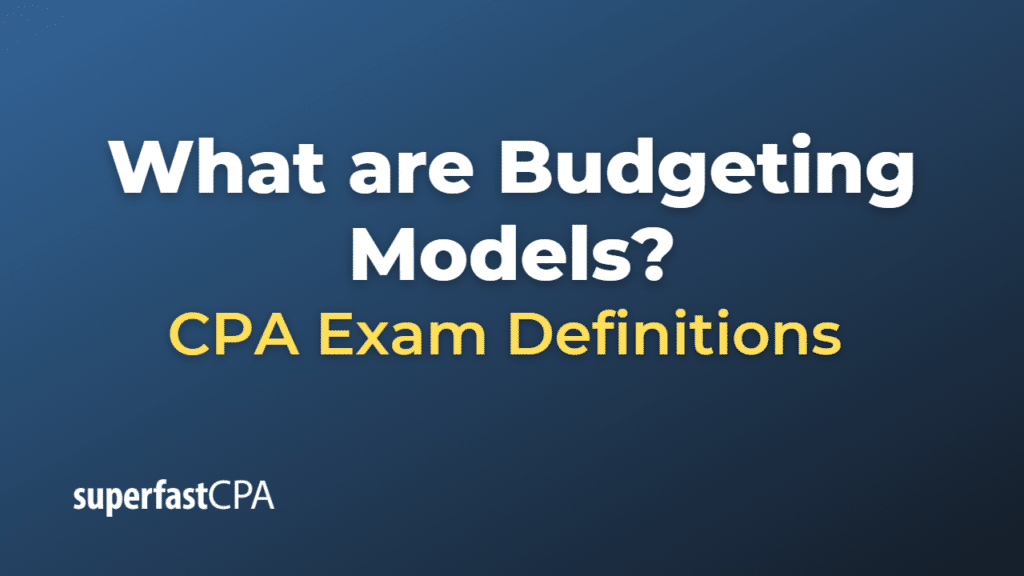Budgeting Models
Budgeting models are different approaches or methods used by individuals, businesses, and governments to plan, allocate, and manage financial resources. These models provide a framework for estimating revenues and expenses, prioritizing spending, setting financial goals, and monitoring financial performance. Here are some common budgeting models:
- Incremental Budgeting: Incremental budgeting uses the previous year’s budget as a starting point and makes adjustments for inflation, changes in revenue, or other factors. This model is relatively simple to implement and maintains stability in spending patterns. However, it may not account for significant changes in organizational priorities or market conditions.
- Zero-Based Budgeting: In zero-based budgeting, every expense must be justified for each new budgeting period. This model requires a thorough examination of all expenses, encouraging efficiency and cost reduction. However, it can be time-consuming and may not be suitable for organizations with limited resources or complex operations.
- Activity-Based Budgeting: This model focuses on the cost of activities that drive the organization’s operations. By identifying the cost of each activity, managers can make informed decisions about resource allocation, process improvements, and cost reduction. Activity-based budgeting can be more accurate and informative than traditional methods, but it requires detailed data on activities and resources.
- Rolling (Continuous) Budgets: Rolling budgets are updated continuously or periodically (e.g., monthly or quarterly) to extend the budget period by one additional period. This model allows for flexibility and ongoing financial planning, adapting to changes in the organization’s environment or performance. However, it can be more labor-intensive than other models.
- Program Budgeting: In program budgeting, resources are allocated to specific programs or projects based on their objectives and expected outcomes. This model emphasizes the link between financial resources and organizational goals, enabling managers to prioritize initiatives and evaluate their effectiveness. However, it may require significant data and analysis to implement effectively.
- Performance-Based Budgeting: Performance-based budgeting ties resource allocation to measurable performance goals or indicators. This model encourages efficiency and accountability by linking spending to desired outcomes. However, it can be challenging to develop appropriate performance measures and may not account for external factors that influence performance.
Each budgeting model has its advantages and disadvantages, and the choice of the model depends on the organization’s size, complexity, and specific needs. It’s crucial to evaluate and select the budgeting model that best aligns with the organization’s goals and circumstances.
Example of Budgeting Models
Let’s consider a small business looking to implement a zero-based budgeting model. The business owner wants to review all expenses and justify them for the upcoming year to ensure efficient resource allocation and eliminate unnecessary costs.
Example:
The business owner analyzes the expenses for the next year as follows:
- Rent: The business owner is currently renting office space for $3,000 per month. As this cost is necessary to maintain operations, the business owner justifies the rent expense and keeps it in the budget.
- Marketing: The business spent $2,000 per month on marketing last year. However, upon further analysis, the owner finds that a $500 monthly investment in social media advertising yielded better results than traditional print advertising. The owner decides to allocate $1,000 per month for marketing, focusing on digital channels to maximize return on investment.
- Office Supplies: Last year, the business spent $500 per month on office supplies. The owner decides to implement a more stringent inventory management system and negotiate better deals with suppliers, reducing the office supplies budget to $400 per month.
- Employee Training: The business owner has allocated $1,000 per month for employee training programs. After evaluating the effectiveness of previous training, the owner decides to invest in a more targeted training approach, cutting the budget to $750 per month without sacrificing employee development.
- Miscellaneous Expenses: The owner reviews various miscellaneous expenses, such as travel and entertainment, and realizes that many of these costs can be reduced or eliminated by utilizing video conferencing and other cost-saving measures. The owner decides to cut the miscellaneous expenses budget from $1,000 per month to $500 per month.
After implementing zero-based budgeting, the business owner has a clearer understanding of each expense and has been able to reduce the overall budget. This budgeting model has helped the owner make informed decisions, eliminate unnecessary costs, and allocate resources more efficiently.













